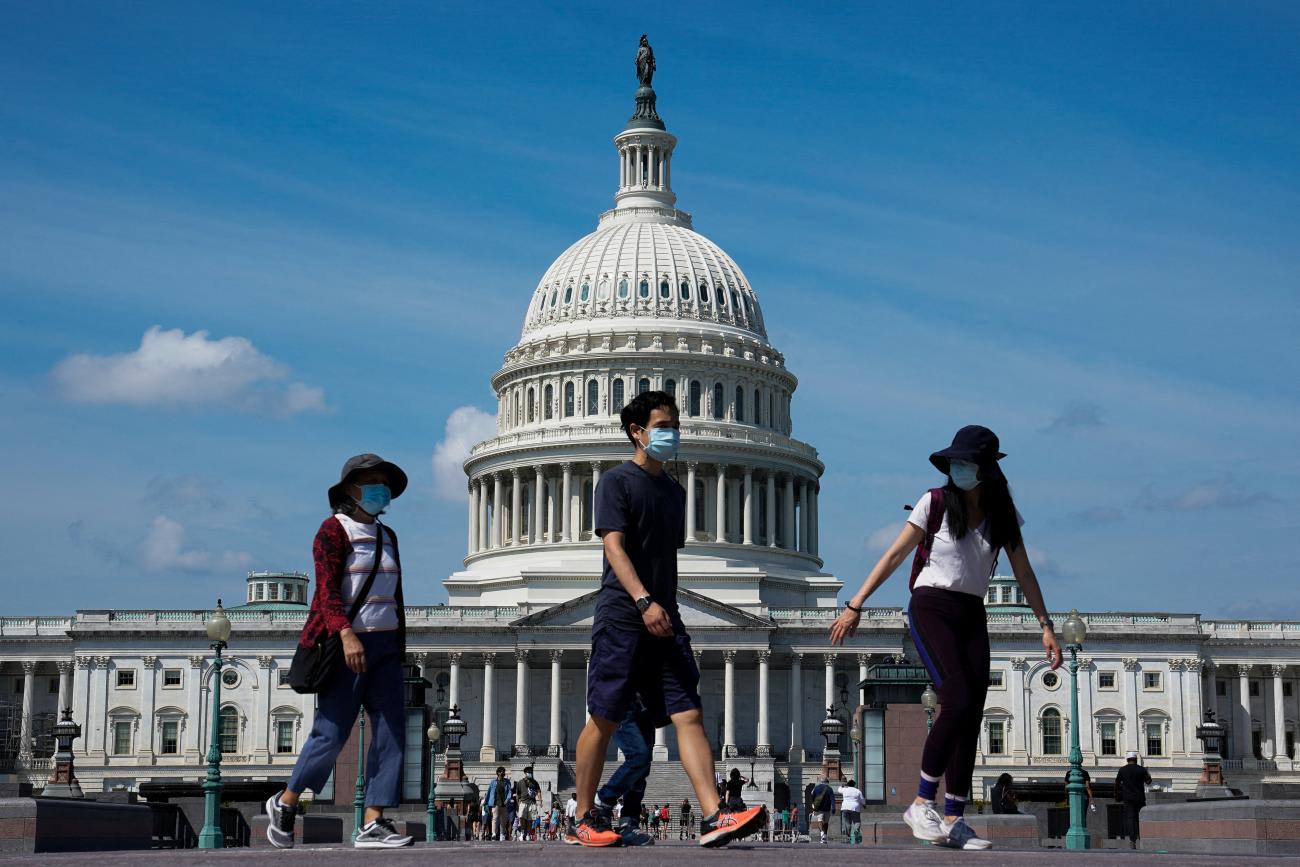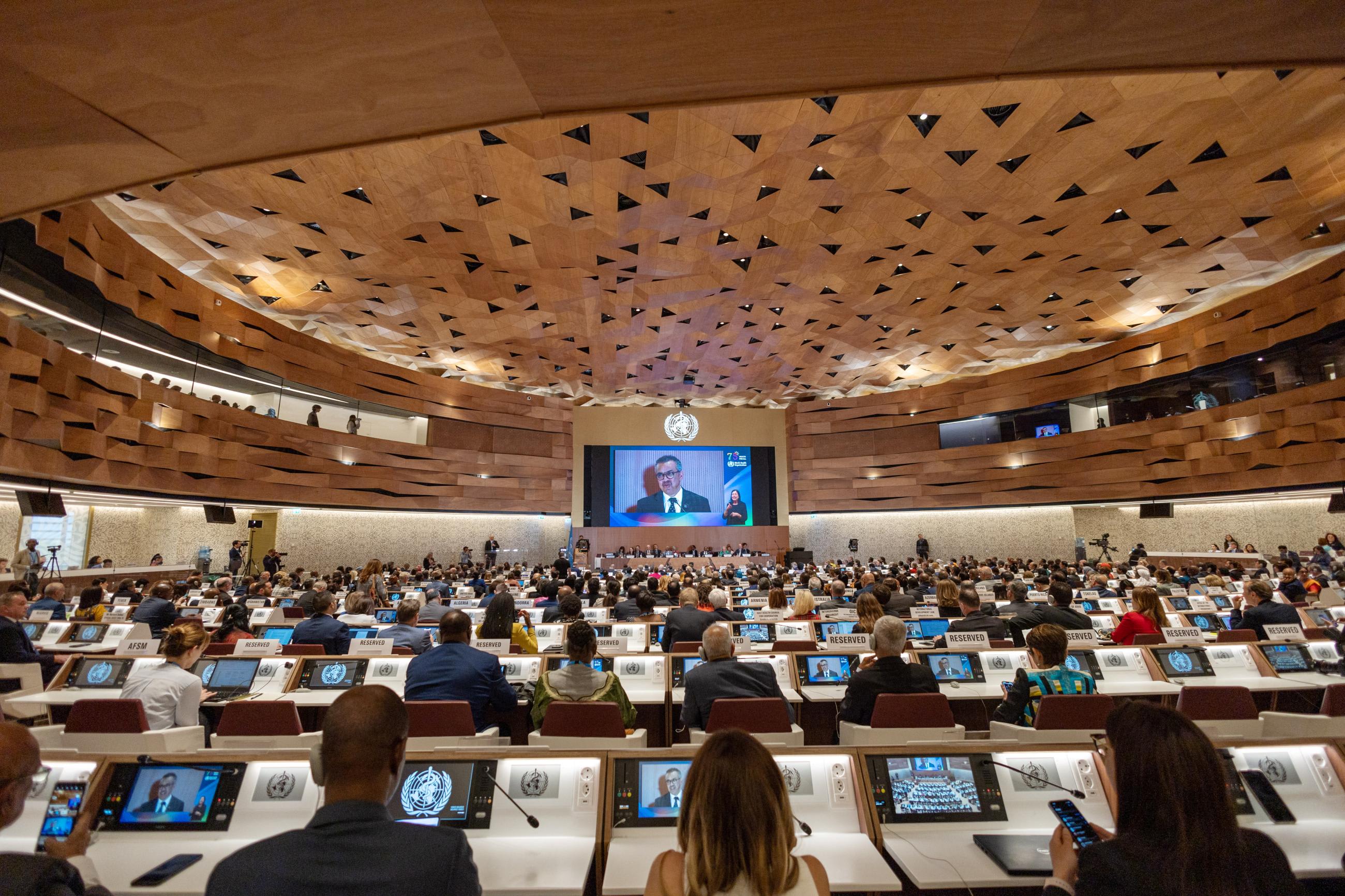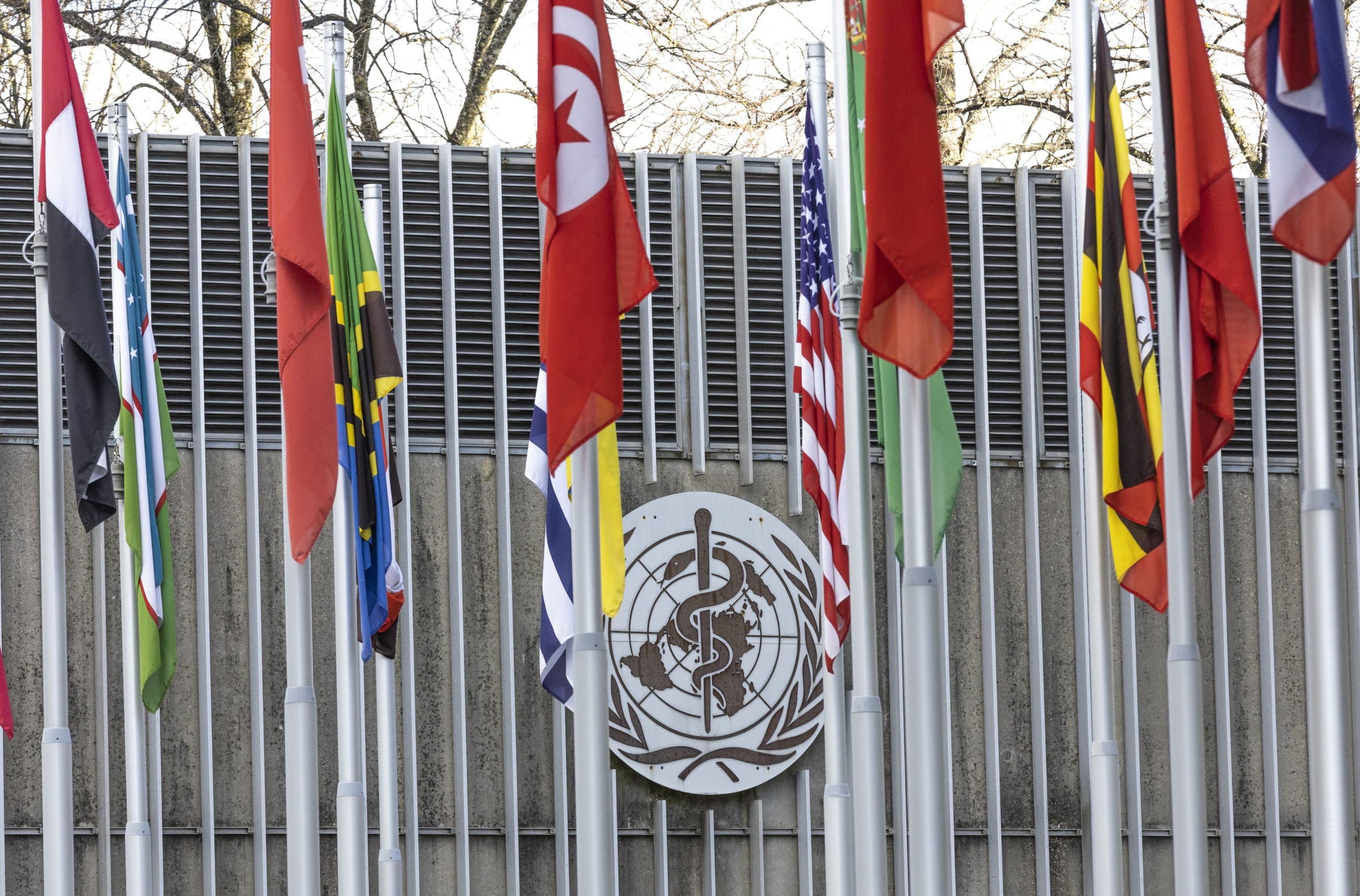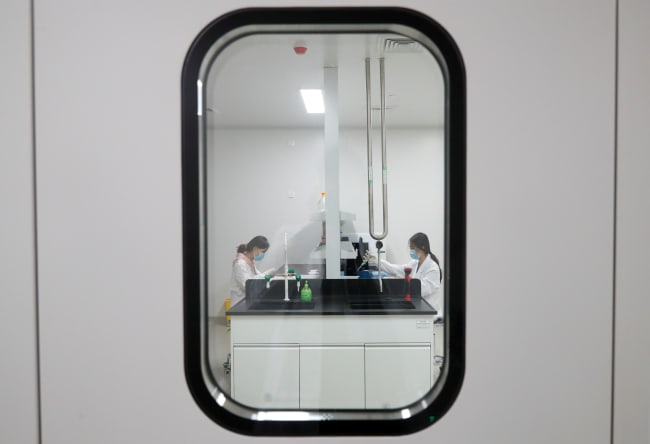The latest draft of the Pandemic Agreement, an international accord under the Constitution of the World Health Organization (WHO) intended to address the shortcomings of the global response to the COVID-19 pandemic, was leaked on Wednesday.
After two years of meetings, WHO member states and the Intergovernmental Negotiation Body (INB) for the agreement will enter their final negotiation session on April 29 with the deadline of approving a final instrument at the World Health Assembly in late May. An instrument in this context is a binding legal arrangement between countries, such as a convention, framework agreement, or treaty.
Think Global Health sat down with Alexandra Phelan of the Johns Hopkins Center for Health Security and Nina Schwalbe of Spark Street Advisors, who have been closely following the negotiations to understand where the agreement started, its status, and the process happening in the weeks ahead.
□ □ □ □ □ □ □ □ □ □ □ □ □ □ □
Think Global Health: Why did WHO member states agree to negotiate a legally binding pandemic agreement amid the COVID-19 crisis?
Alexandra Phelan: Fundamentally, when member states held a special session during COVID-19, it was in recognition of a significant lack of preparedness globally and a significant lack of response. When countries adopted a resolution that was the impetus to start negotiating this potential pandemic instrument, they started pushing words like equity and solidarity. Those guiding principles were intended to be the push for a negotiation for an instrument and recognition of these failures in the international system. Now, many gaps in the international legal system have been identified.
First [during the initial year of COVID-19], the Independent Panel on Pandemic Preparedness and Response (IPPR), recognized gaps in the current legal architecture, that countries hadn't been complying with International Health Regulations, that they really don't apply to a lot of things in terms of [pandemic] response—and apply to nearly nothing in prevention.
The European Council also pushed for an international instrument [in early 2021], and this was where the first language around a pandemic treaty emerged. That was very quickly taken up, and at the time heads of state weren't really aware that International Health Regulations already existed to some degree. Certainly, the regulations were not on their radar as the core binding international legal instrument that governs these issues, which was very telling and which the IPPR had alluded to.
Think Global Health: What specific problems exposed by COVID-19 is the agreement intended to address?
Nina Schwalbe: One of the big problems COVID-19 exposed was the lack of equity. Certainly, that was within countries, but it was also between countries. The negotiations have emphasized the really sticky issues that were objectively unfair.
This problem drills down to access to countermeasures when they became available. High-income countries essentially hoarded countermeasures, and low-income countries got them way too late. In addition to more general ideas about solidarity, access really became the hot ticket item that this treaty was trying to solve.
One would hope the motivation was also around the realization that pandemics require interstate, intergovernmental action and the world really didn't know how to do it. There were so many unknowns, and, as Alex said, existing laws and existing treaties that people didn't know about and thus made decisions counter to those policies.
Alexandra Phelan: I'd add that even though problems from COVID-19 drove and still underpin the treaty, other interests have influenced what the treaty now intends to address. Although it wasn't necessarily a big issue to have [biological] sample and [genetic] sequence sharing beyond the first two weeks, a hot topic for the Global North has been to integrate the idea of equitable benefits sharing. The Global North is pushing obligations for it, but the Global South is connecting the issues, emphasizing that they can't be pushed to share sequences and samples and not share the equitable benefits.
Additional topics have been brought in, and they've distracted or shifted the dynamics of how equity is being operationalized.

Think Global Health: As you have touched upon, many low- and middle-income countries and global health experts believe that the Pandemic Agreement should include a pathogen access and benefit-sharing system, or PABS. What are the core components of such a system?
Alexandra Phelan: The details of what a PABS is going to look like have been deferred down the line, and discussion is now under way of a new instrument that will detail how a PABS will operate. At its core, any sort of access and benefit sharing system is about ensuring access to genetic resources as well as the genetic sequence information—not just for pathogen samples but also the sequence information from them.
The access should be on equal footing with the equitable sharing of benefits that arise from the use. That includes things like vaccines, diagnostics, and therapeutics. The origins of access and benefit sharing go back quite some time.
In the absence of a PABS, how the current legal regime operates is that countries that are party to the current international agreement, the Nagoya Protocol can create domestic legislation that requires their informed consent before accessing genetic resources and that those genetic resources are shared subject to mutually agreed terms..
That typically happens bilaterally, and the core difference of a PABS is that it would be multilateral. Benefits are shared on the basis of public health needs, risks, and demands rather than directly in exchange for access.
I do want to put an asterisk because, in the latest draft that has come out, we see a connection to access much more clearly. Rather than simply [covering] the equitable sharing of benefits that arise from the use of pathogen samples and sequences generally, the latest text ties the use to the products more specifically. Whether and how that goes in the next round of negotiations is unclear, but it's important to think in terms of three components of PABS: access, equity benefit sharing, and the multilateral aspect.
Think Global Health: Where do the negotiations currently stand on including a PABS mechanism in the Pandemic Agreement? Given the diplomatic impasse on the PABS system, what strategies can negotiators use to resolve it or prevent the standoff from damaging the prospects of the Pandemic Agreement?
Nina Schwalbe: It's at such an impasse that they're basically deferring all discussion of this to a future date [by May 2026]. The recent draft and WHO resolution make a broad reference to a PABS and put down some fundamentals around equity and what they hope to achieve.
The draft proposes putting together an intergovernmental working group to develop the PABS proposal further. It also proposes two articles in the WHO constitution that can result in legally binding treaties for member states.
The WHO constitution includes Articles 19 and 21. [As Think Global Health previously wrote "Under Article 19, WHO member states become bound by the convention if they affirmatively become a party. Regulations adopted under Article 21 become binding on WHO member states except those that reject them."]
The agreement is being proposed under Article 19 and will be governed by a Conference of Parties, which means that anybody who signs up to the treaty then governs the treaty. Article 21 is a different part of the WHO constitution, under the governance of the World Health Assembly, and that's where the International Health Regulations sit.
Back to your question on a PABS: What they've said is, here're some fundamental principles around which we want a PABS to be created. We're going to ask a working group to take [this] forward, and then we're going to put it under Article 21—and under the World Health Assembly in terms of monitoring its operationalization.
All the meat on the PABS was taken out of the draft, and its fate is "to be continued."
All the meat on the PABS was taken out of the draft, and its fate is "to be continued"
Nina Schwalbe
Think Global Health: The United States is an important player in global health, and Joe Biden's administration has actively participated in the negotiations for a pandemic agreement. What does the Pandemic Agreement need to include, or exclude, for it to receive sustained commitment from U.S. policymakers?
Nina Schwalbe: The effort is being led and coordinated by the White House and involves many actors in the U.S. government. A treaty will have to be ratified by Congress. Opinions are numerous, and although the Biden administration has some ambition to push forward ideas, it's also quite mindful that the process of going through the U.S. government is a long one.
They've put some red lines down on the protection of intellectual property rights, but in some areas they've been quite progressive. One is pushing for compliance and accountability, for which they've received a lot of pushback from within the negotiations.
Civil society would like the administration to be strong on conditionalities around public funding. That means when private companies receive public funding to develop products, those products and their intellectual property would be made available so that other companies, particularly in developing countries, can also make those products.
Alexandra Phelan: When it comes to this sort of broad approach to intellectual property, research, and development, it expands into pathogen access and benefits sharing, too. This is one area where industry players have been quite vocal.
What I think would be critical to the United States would be ensuring that the access to the samples and sequences side of PABS is not unduly limited or restricted in any particular way. In the text of the Pandemic Agreement itself, and then any subsequent PABS instrument, a lot of focus and attention will be on ensuring as unimpeded access to genetic resources and sequence data as possible.
Think Global Health: The COVID-19 pandemic increased interest in strengthening compliance and accountability mechanisms concerning pandemic preparedness and response. How have the negotiations addressed the perceived need to hold countries more accountable for their compliance with international law?
Nina Schwalbe: They have not. Except for one mention in a subparagraph of the PABS system, no reference is made to any sort of compliance or accountability mechanism for the treaty. There's no provision for monitoring compliance of the commitments, however weak or strong, that member states are making.
Alexandra Phelan: What is so startling is that this was the core message coming out of the special session and the points being made around the International Health Regulations. Yet how to actually do that and create compliance has just been completely put to the side.

Think Global Health: Geopolitical competition and the polarization of domestic politics in many countries adversely affected responses to the COVID-19 pandemic. How have those political problems affected the negotiations on the Pandemic Agreement?
Nina Schwalbe: [As nonstate actors], we're not allowed in the room [during negotiations], so we sit in the cafeteria and try to grab negotiators as they come out, to talk to them, to advocate with them, to get their impressions of what's happening in the room.
I've been impressed by the negotiators' steadfast commitment to this process. They're exhausted, and they're working hard to try to get to a yes. They've really done a good job of shutting out the noise and focusing on the task ahead. They are committed public health people who believe that in a meaningful agreement to prepare for the next pandemic. If this treaty fails, it will be because member states didn't feel that the commitment was meaningful. It will not be because of antitreaty noise in the ether.
Alexandra Phelan: I agree. That noise will be relevant if a treaty is adopted. There do seem to be both words of good faith, commitments, and a degree of action. Sometimes, however, the plenary commitments to wanting a treaty could be more optimistic and more committed than the willingness to come to consensus on provisions.
We are at a particular moment of interrogation for international law in the multilateral system. Multipolarization is core, and the shift away from a unipolar world is reflected in the dynamics of how, for example, equity and access and benefit sharing have become main issues.
But this trend also plays into any possible hesitation to come to consensus. It reflects a broader international system and the dynamics that are occurring globally. The negotiations can't be divorced from those broader considerations at play.
Think Global Health: At the end of May, the World Health Assembly is scheduled to consider and adopt the Pandemic Agreement. With final negotiations resuming on April 29, what is the anticipated projection for this agreement?
Alexandra Phelan: The original time lines were that the first five days of negotiations were going to focus on the substantive content. Part of the reason for that is that countries have a lot of internal processes that have to occur before the World Health Assembly. May 5 was going to be the stop point of the content negotiations with a stock take on Friday, May 3. The remaining week was going to be reserved for working out the legal language.
Member states can't negotiate all the way up to the World Health Assembly, so early May is likely when they'll give us things.
Think Global Health: Is there anything that you'd like to raise that you think is important that we've missed?
Nina Schwalbe: A point I find interesting is that this is probably one of the first major treaties to be negotiated in part by Zoom. An issue with that is when member states give their positions, they know a lot of people from home are listening. That gives them less freedom to operate than they would have in more traditional negotiations.
Alexandra Phelan: That's spot on. There's a meta question about the way these negotiations have been structured and what lessons were not taken from other international negotiations beyond just the transparency and civil society participation points. This includes being comfortable with conflict in the room and with using that tension to help maintain progress.
This process of pandemic preparedness and response is not going to depend just on the text. It will depend on implementation. It's more than simply creating more texts. It's about rebuilding trust.

EDITOR'S NOTE: This interview has been edited for length and clarity.












